67 Cold Calling Statistics for Successful Sales Outreach
67 Cold Calling Statistics for Successful Sales Outreach

Have you heard the phrase "cold calling is dead" before?
It's understandable if some of you agree with that statement. Everyone is busy, and no one enjoys being disturbed during a hectic day by strangers marketing their products or services. Many individuals believe it's a waste of time because various business tech trends such as social media and automated email marketing have proven to be effective tools for outreach campaigns.
However, there are many benefits of cold calling that are completely overlooked. According to statistics, cold calling plays a critical role in the success of many top-rated sales professionals.
Check out this list of 56 cold calling statistics, plus an additional 11 stats sprinkled throughout, for a total of 67 helpful statstics that demonstrate the benefits and challenges of cold calling.
Cold calling may seem old-fashioned, but it remains tried and true. Check out these cold calling stats that showcase the average sales professional’s cold outreach strategy.
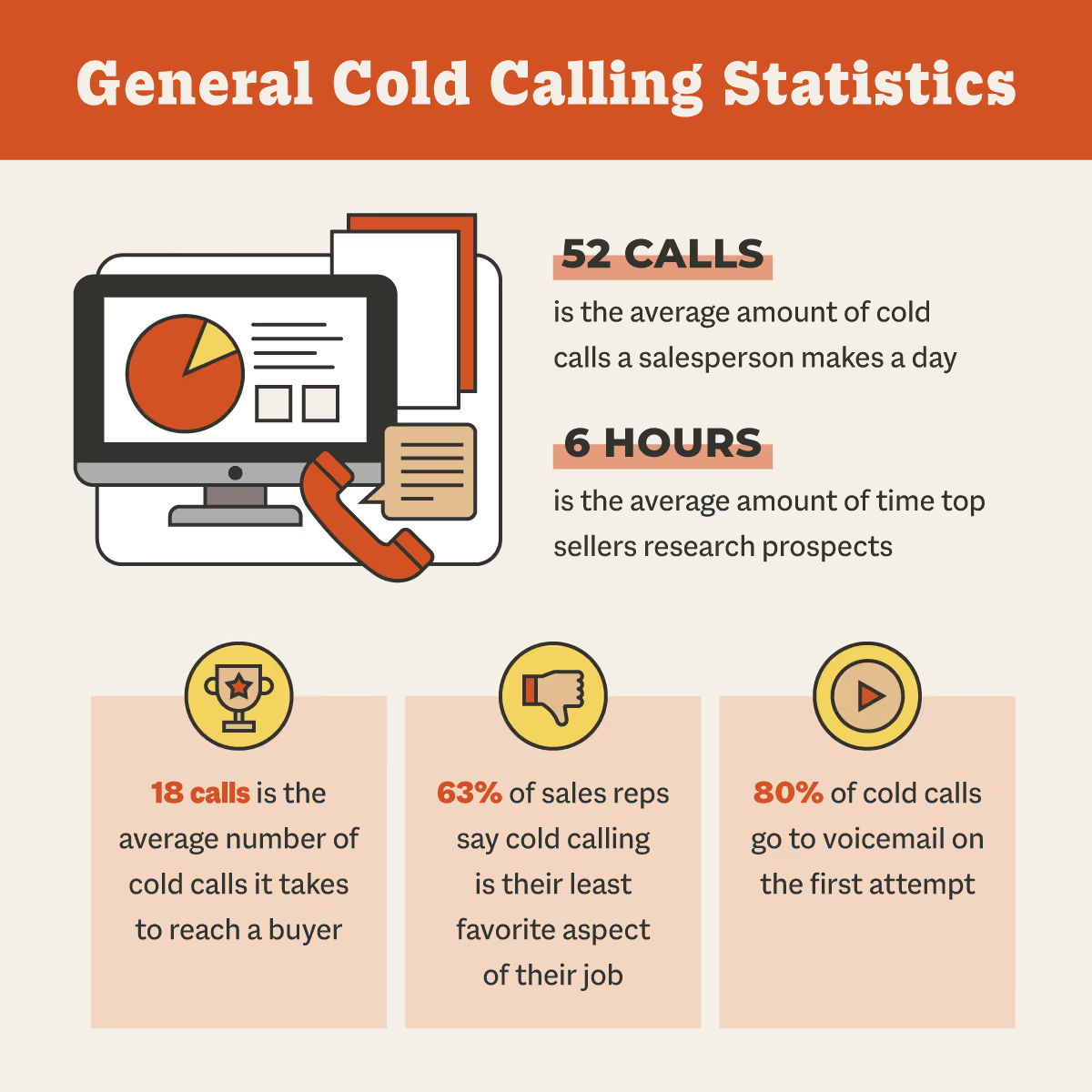
- The average salesperson makes 52 calls per day. (The Bridge Group)
- It takes an average of 18 phone calls to reach a buyer. (HubSpot)
- 80% of cold calls go to voicemail. (RingLead)
- 90% of first-time voicemails are never returned. (RingLead)
- 28% of all completed cold calls are considered “productive.” (Forbes)
- 49% of buyers prefer cold calling as the first point of contact. (HubSpot)
- Only 1/3 of a salesperson's day is spent actually selling. (HubSpot)
- Top sellers devote an average of 6 hours per week to researching their prospects. (Crunchbase)
- 63% of sales reps say cold calling is the most disliked aspect of their job. (ZoomInfo)
- 92% of all customer interactions happen on the phone. (Salesforce)
B2B cold calling statistics
Cold calling methods are still the core of a solid marketing strategy and where B2B sales begin. Check out these B2B cold calling stats to gain insights on the best strategy for your own team.
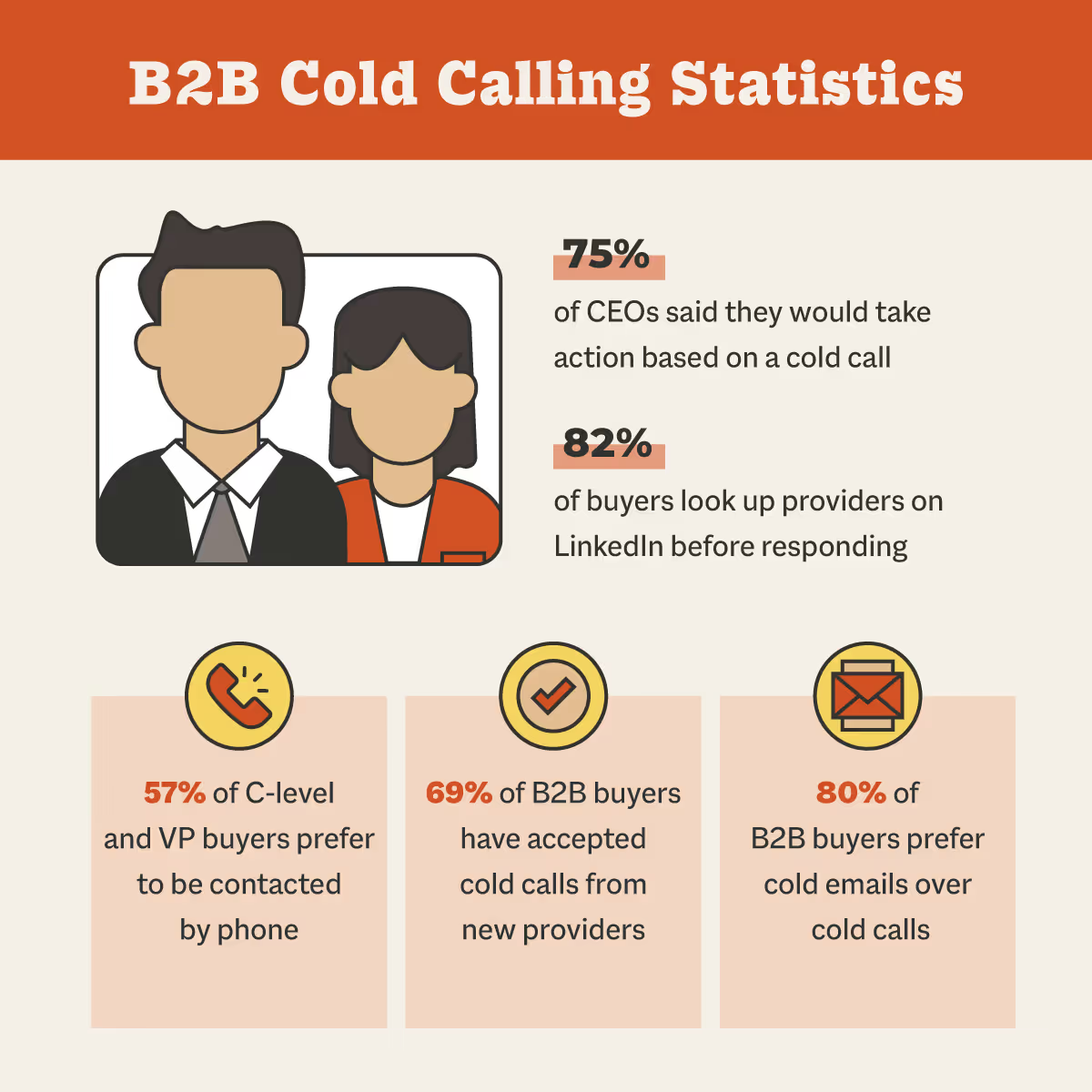
- 57% of C-level and VP buyers prefer to be contacted by phone. (RAIN Group)
- 82% of B2B decision-makers think that sales reps are unprepared before a cold call. (MarketingProfs)
- Before responding to outreach efforts, 82% of buyers look up providers on LinkedIn. (RAIN Group)
- 75% of CEOs surveyed said they would book an appointment or attend an event based solely on a cold call or email. (Close)
- Cold emails are preferred by 80% of business purchasers over cold calls. (RAIN Group)
- When they're actively looking for a solution to an issue, 62% of buyers want to hear from sellers. (LinkedIn)
- 69% of B2B buyers accepted a cold call from new providers. (Crunchbase)
Cold call success rates
So, is cold calling still effective? We’ve outlined some statistics of cold calling success so you can assimilate some of these effective methods within your outreach efforts.
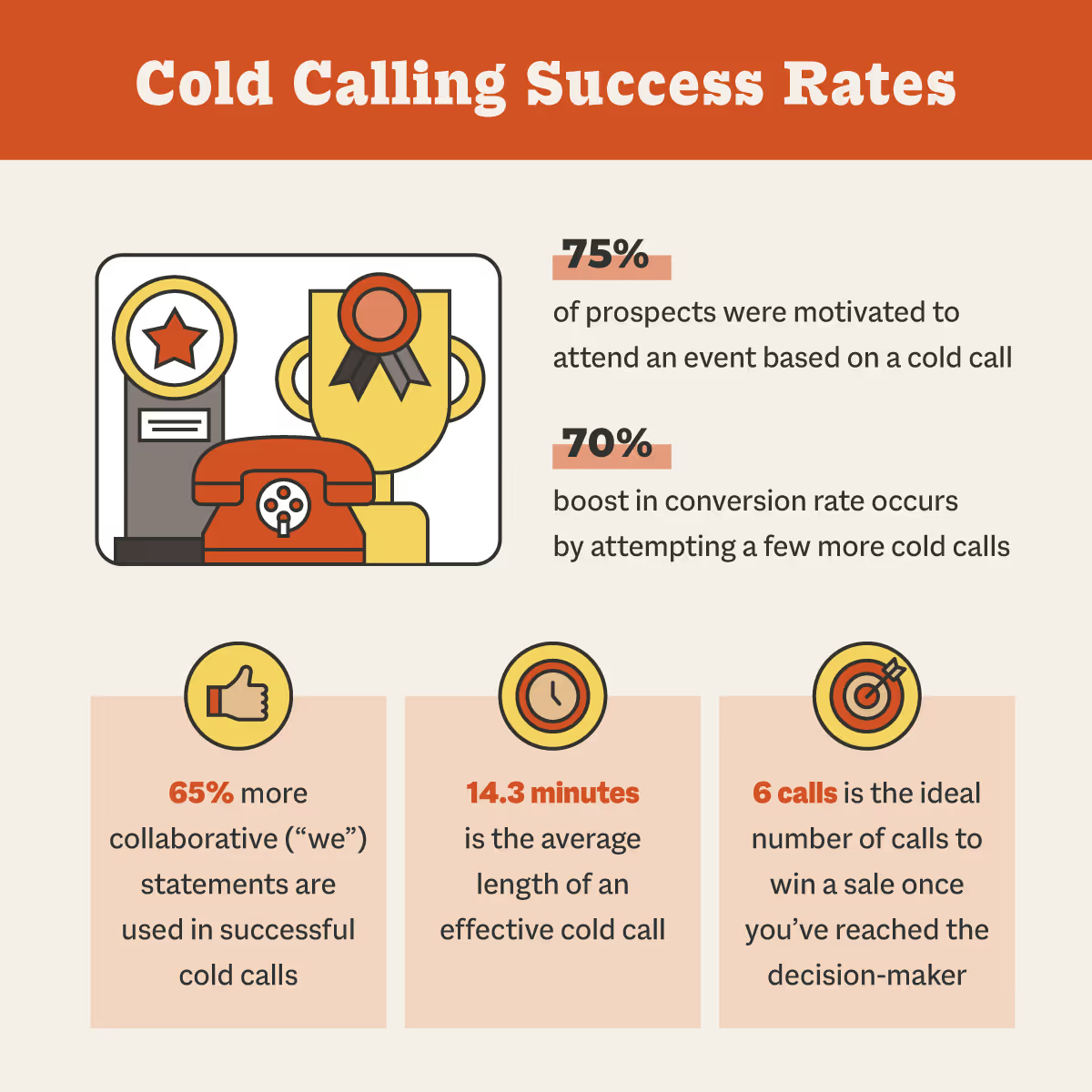
- Unexpected cold calls prompted 75% of prospects from various industries to attend an event or schedule a meeting. (ZoomInfo)
- The most effective sales prospecting calls last an average of 14.3 minutes. (Revenue.io)
- Sales reps can boost the conversion rate by 70% by making only a few more cold call attempts. (CallHippo)
- 65% more collaborative statements like “we” rather than “I” are used in successful cold calls. (Gong.io)
- On Wednesdays, the success rate of cold calls is 46% greater than on Mondays. (CallHippo)
- 6 is the ideal number of calls to win a sale once you've reached the decision-maker. (Crunchbase)
- A 450% disparity in response time exists between leads who receive a follow-up phone call within an hour of placing an inquiry and those who do not. (CallHippo)
Cold calling mistakes and challenges
Cold calling is often the most challenging and least favorite part of a sales rep’s job. From phone call anxiety and poor communication to annoyed or reluctant prospects, check out some of these common mistakes and challenges sales reps face while cold calling.
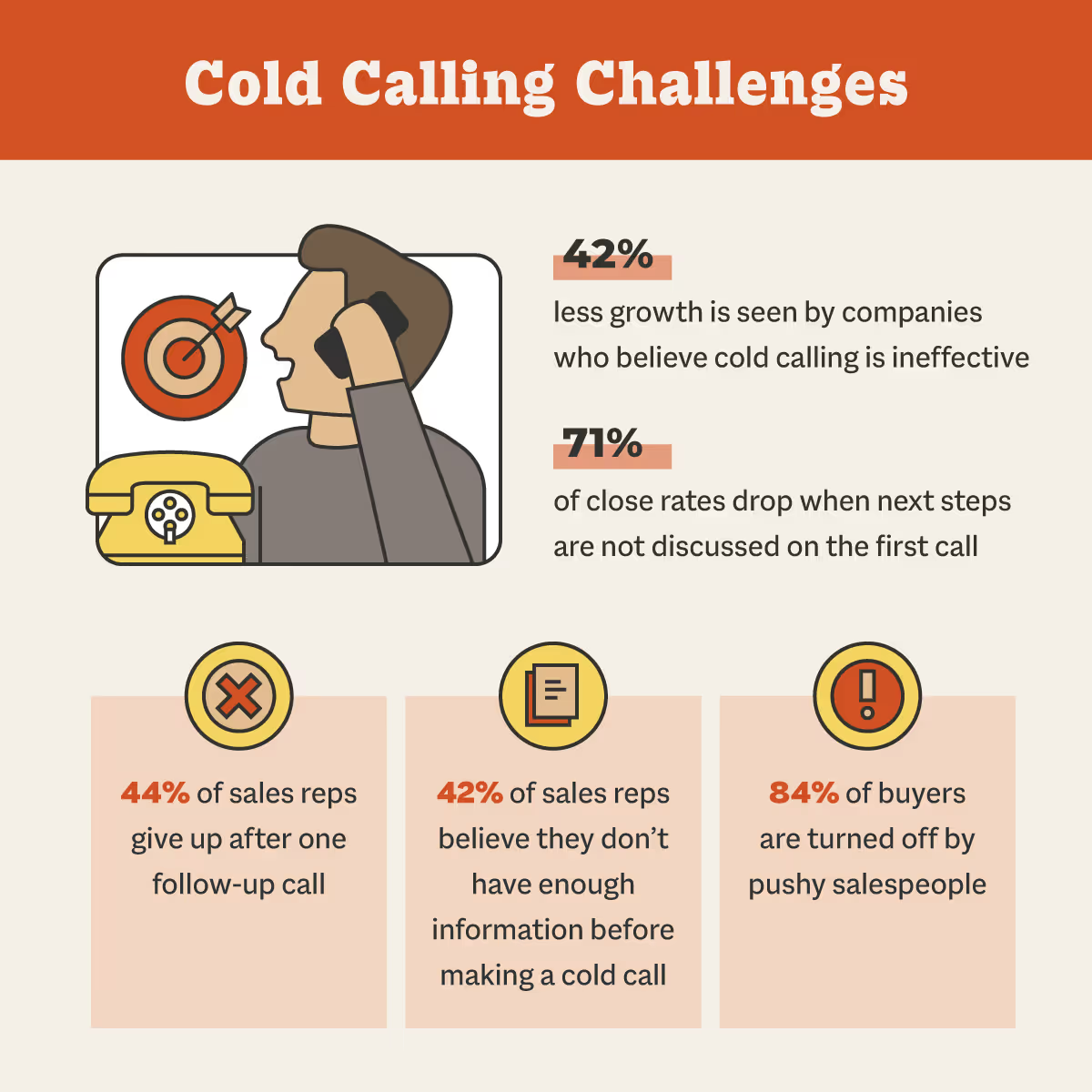
- Cold calling is ineffective 90% of the time. (Harvard Business Review)
- 80% of prospects would rather talk to a salesperson over email than a call. (Salesmate)
- Companies who believed cold calling was no longer effective experienced 42% less growth than those that did not. (Zippia)
- Due to reluctance, 80% of new salespeople fail. (Yesware)
- When following steps are not discussed on the first call, close rates drop by 71%. (Gong.io)
- After the initial contact, almost 30% of leads never receive a follow-up call. (Call Hippo)
- After 1 follow-up, 44% of sales reps give up. (The Brevet Group)
- 90% of purchasers will never reply to an unsolicited contact. (Iron Paper)
- 88% of buyers will have nothing to do with cold callers. (Iron Paper)
- Before making a call, 42% of sales reps believe they don't have enough information. (DNB)
- 71% of sales professionals think they waste too much time entering data. (Heinz Marketing)
- Only about 1% of cold calls result in an appointment. (Baylor University)
- A cold call voicemail won't hold a prospect's attention for more than 30 seconds. (Inside Sales)
- Each second spent exceeding your 30-second limit reduces your chances of interacting with customers by 2%. (Inside Sales)
- On a cold call, asking, "Is now a bad time?" reduces your chances of getting a meeting by 40%. (Gong.io)
- Unidentified calls are thought to be fraudulent by 92% of consumers. (Hiya)
- Unidentified calls go unanswered in 79% of cases. (Hiya)
- 84% of buyers are turned off by pushy sales practices. (Fit Small Business)
- The worst time to make a cold call is Friday afternoon. (Crunchbase)
- Only 52% of salespeople believe they are effective at gaining access to key players. (Salesforce)
- 40% of salespeople feel that prospecting is the most challenging part of the sales process. (Salesmate)
Cold calling techniques that really work
Even though cold calling has its fair share of challenges, there are some cold calling best practices that will help you catch your sales leads’ attention and pique their interest. We’ve outlined some of the best cold calling techniques so you can incorporate them into your prospecting and lead generation strategies.
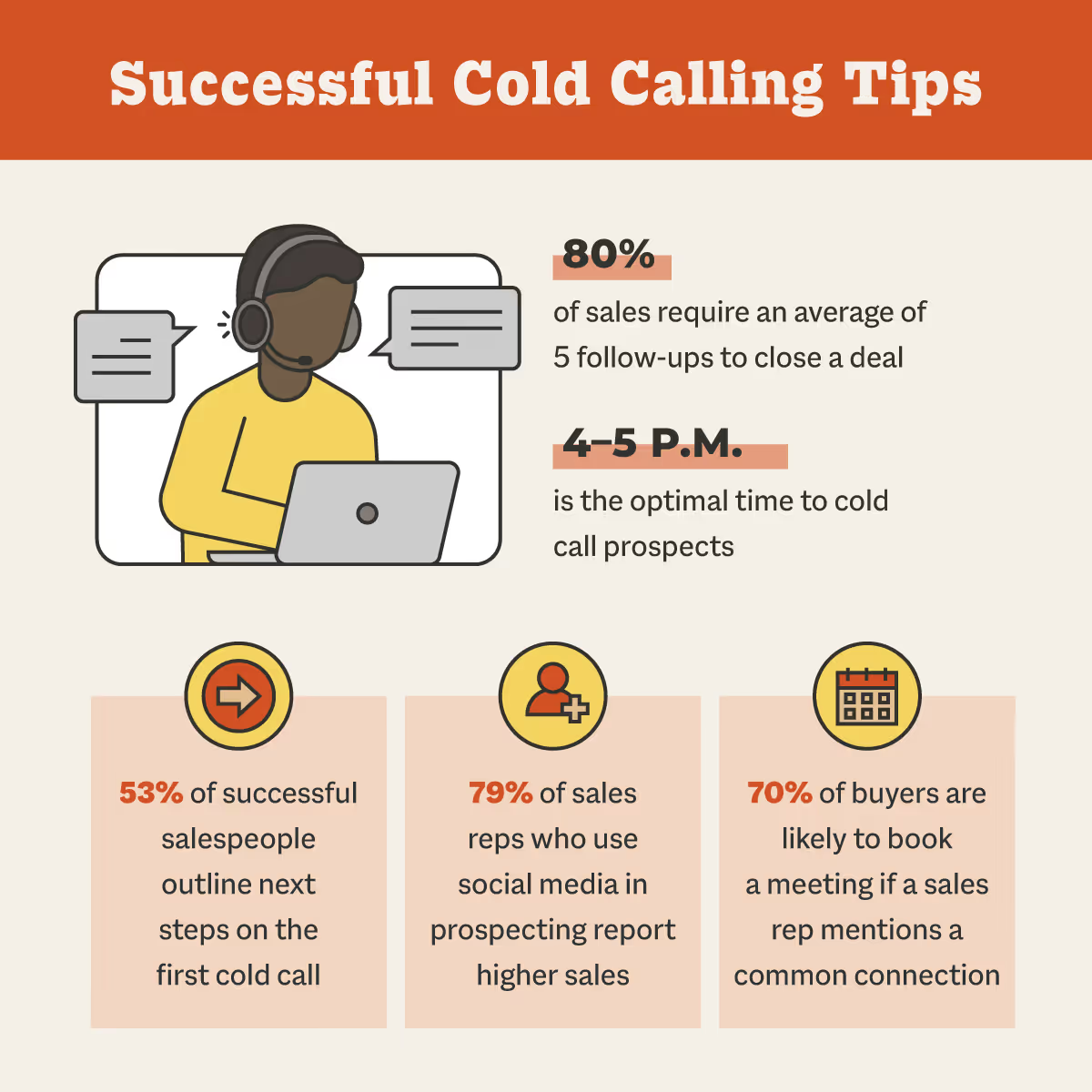
- The optimal times to make a cold call are between 11:00 a.m. and 12:00 p.m. or 4:00 p.m. and 5:00 p.m. (Salesmate)
- To close a sale, 80% of sales require an average of 5 follow-ups. (Brevet)
- The fastest-moving sellers spent 53% more time outlining next steps on their cold calls. (Gong.io)
- Calling prospects shortly after they open your email can increase your connect rate by 32%. (Yesware)
- Successful cold calls often have a 55:45 talk-to-listen ratio. (Crunchbase)
- On a cold call, you have 5-10 minutes to demonstrate your value to prospects before they lose interest. (RAIN Group)
- If you call a lead within the first 5 minutes of them submitting a web form, they're 100 times more likely to answer the phone. (Inside Sales)
- Starting your cold call by explaining why you're calling can boost your success rate by 2.1 times. (LinkedIn)
- Cold calls that are successful have 77% more "speaker changes per minute" than those that are unsuccessful. (LinkedIn)
- When it comes to prospecting, about 79% of sales reps who use social media report higher sales than agents who don't. (A Sales Guy)
- During a cold call, mentioning a shared connection, such as a referral, can raise the likelihood of getting a meeting by 70%. (LinkedIn)
FAQ about cold calls
What is the success rate of cold calling?
Cold calling has only a 2.5% success rate, according to a study from Kenan-Flagler Business School. This is an extremely low percentage compared to other outreach methods.
However, cold calling can still be effective and should be incorporated into the overall marketing strategy. Sales reps can raise their cold call conversion rate and increase their chances of generating a sale by completing thorough research before contacting prospects and customizing their marketing and sales pitches.
What is the best time to make a cold call?
According to Salesmate, the best times to make a cold call are between the hours of 4:00 p.m. and 5:00 p.m. when prospects are winding down for the day. The second best time is in the early morning before lunch from 11:00 a.m. to 12:00 p.m.
There is a remarkable 71% difference in the number of discussions between 4:00 and 5:00 p.m. and the number of interactions between 11:00 a.m. and 12:00 p.m.!
The best days to cold call are Tuesday, Wednesday, and Thursday — Wednesday being the best day. Avoid cold calls on Mondays when people are busy setting up for the week and Friday afternoons when most people are already checked out mentally for the weekend.
What are the odds of cold calling?
In 2007, it took an average of 3.68 cold call attempts to contact a prospect. Nowadays, it takes an average of 8 attempts to reach someone.
The average salesperson gives up after only 2 attempts to reach a prospect. The lesson here is to not give up and be persistent. If a buyer keeps avoiding your calls, change up your strategy and use another method to help warm up the prospect until they are ready for a phone call.
Is cold calling the most effective?
The phone is the most effective sales tool according to 41% of sales representatives. That comes as no surprise, as phone calls are one of the best ways to nurture leads and build better connections with them.
However, it’s not the most effective method for cold outreach, as email marketing takes the cake. In fact, email marketing has 2x the ROI than cold calling. Still, phone calls will grab a lead’s attention far more quickly than an email.
For best results, use a multichannel strategy using various tools such as social media, email, live chat, and phone calls. To communicate with their prospects and find success, 51% of businesses employ at least 8 different channels. That way, you can warm up a cold lead before the first phone call.
Let Smith.ai’s virtual receptionists level-up your cold calls
Now that you've read these cold calling statistics, you know that this tried-and-true tactic can still work; all you need to do is employ the proper techniques and the best outreach sales team you can find.
To help get the most out of your cold calling strategy, try our virtual receptionists who specialize in handling your cold sales calls, appointment setting, and lead intake and qualification so you can focus more on qualified leads who make your business money.
If you enjoyed these cold calling statistics, make sure to check out our 75 customer experience statistics to find out how your business can achieve a higher level of customer satisfaction.
Take the faster path to growth. Get Smith.ai today.
Key Areas to Explore
Technical Implementation Terms
Voice user interface (VUl) design
Speech recognition integration
Text-to-speech optimization
API connectivity and webhooks
Real-time data synchronization

Your submission has been received!














.svg)



